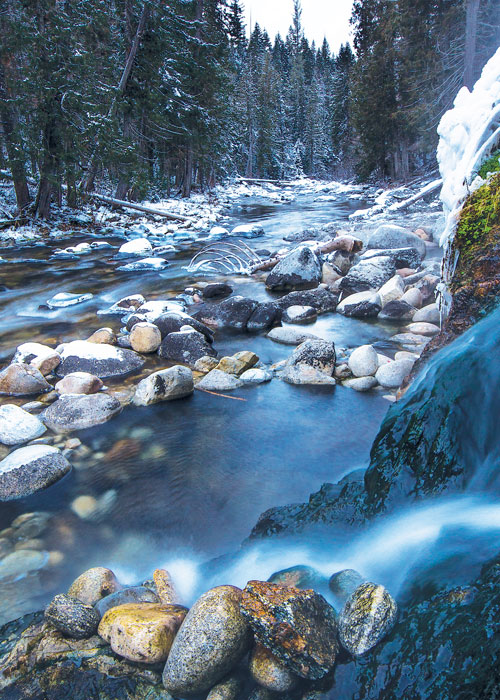The parking lot at Warm Springs Creek trailhead was empty, unusual for a Friday afternoon, even in the depths of winter. Across Highway 12, the Lochsa River, normally tumultuous – its name Nez Perce for “rough water” – lay suspended mid-churn. Meanwhile, just downstream, improbably in the sub-zero chill that flash-froze sweat, Warm Springs Creek poured into the Lochsa. I crossed the pack bridge over the river and followed the trail along Warm Springs Creek, the path hammered smooth by scores of boots. One mile in, a cloud of steam on the downhill side of the path signaled my destination. A quick scramble along the slick edge of a waterfall and I had Jerry Johnson Hot Springs to myself. The pool was bathwater-warm and pleasantly sulphur-free. Around the spring, where cold finally overpowered superheated steam, rime covered everything – cedar sprays, boulders, and eventually my eyebrows. I quickly forgot the record-low cold; there was not a warmer place to be outside in north Idaho at that moment.
Water defines the rugged character of north-central Idaho, none more so than the Lochsa River. Described by Lewis and Clark, who encountered it on their westward journey to the Pacific, as “swift and stony,” the Lochsa was one of the six original rivers protected by the U.S. Congress in the 1968 Wild and Scenic Rivers Act. The snowmelt months of spring bring world-class whitewater rafting, with almost continuous rapids over the forty mile stretch from its headwaters near Lolo Pass on the Idaho and Montana border to the confluence of the Selway, another Wild and Scenic River.
But it’s the hot springs, products of the Lochsa Geothermal System, the geothermal fault that defines the course of the Lochsa River, that draw travelers year-round. Five named hot springs – Stanley, Weir Creek, Jerry Johnson, Colgate Licks and Lolo – follow the fault line, with numerous other springs hidden in the mountains. Although high summer sees a stream of soakers from Lewiston and Missoula and beyond, winter brings its own quiet charms. Here, six months and several dozen degrees removed from summertime crowds, it’s easier to appreciate the invigorating heat of a soak and the quiet beauty of a frozen cedar forest.

A winter traveler’s first stop should be Jerry Johnson Hot Springs, twenty miles west of Lolo Pass. The Warm Springs Creek trail to the springs is by far the most popular trail in the Clearwater National Forest; expect to share a pool with college students from Missoula. An almost-level one-mile hike attains the first and most impressive of eight pools strung out along the east bank of Warm Springs Creek, where a waterfall splashes over a steep rock face into a calf-deep basin.
Spring snowmelt submerges the pool, but in the winter, low creek levels leave the pools relatively warm; hug the rock wall for undiluted, 105-degree water. “Clothing optional” is the custom of the country here and at Weir Creek Hot Springs, although those with bathing suits will not feel out of place. A party destination in the past, Forest Service restrictions prohibiting overnight use – and locals’ justifiable reverence for the spot – have led to a cleaner, safer experience.
Just over 10 miles west of Jerry Johnson Hot Springs, Weir Creek Hot Springs comes as close to a developed hot spring as one will find in the wild. Where the spring pours out of the hillside, dedicated soakers have constructed an engineering marvel, with rock-and-mortar walls mid-thigh high and outflow pipes capped by Coke cans. The pool seats eight comfortably, and a wood plank, well-worn by years of backsides both bare and clothed, provides an elevated view of Weir Creek forty feet below. Soakers can reach the springs via a ¼-mile hike that climbs well above the creek, but treacherously slippery tread, even after a recent Forest Service rebuild, tends to keep winter visitors to a trickle – all the better to enjoy the serene, cedar-shaded setting.
After a soak, exercise invigorated muscles on the newly constructed snowshoe trail at Lolo Pass, which provides one of the few winter vistas of the Lochsa region attainable without aid of a snowmobile. From the front door of the visitor center, the well-marked 1.5-mile route climbs steeply but briefly through the trees before topping out on a small ridge spiked with snags. To the south stretches the heavily timbered Selway-Bitterroot Wilderness, at 1.5-million acres slightly larger than Delaware; the contours of the Lochsa River twist away to the west. The Visitor Center hosts monthly full-moon snowshoe trips through the winter; check the Clearwater-Nez Perce National Forest website for details.
The Lochsa Lodge is also hosting the annual Lolo to Lochsa Nordic Ski Race on March 15. It’s a 22 mile ski race with free registration and bus transport from the lodge. Contact Angela Mallon at [email protected] or call the lodge at (208) 942-3405 for more info.
Getting There: Good directions to Jerry Johnson, Weir, and other Idaho hot springs are available at www.idahohotsprings.com/destinations/jerry_johnson.













